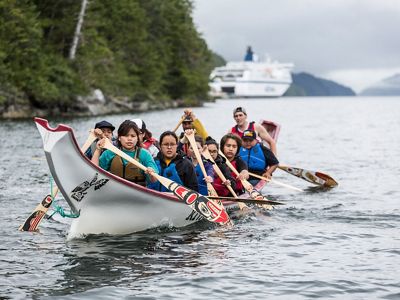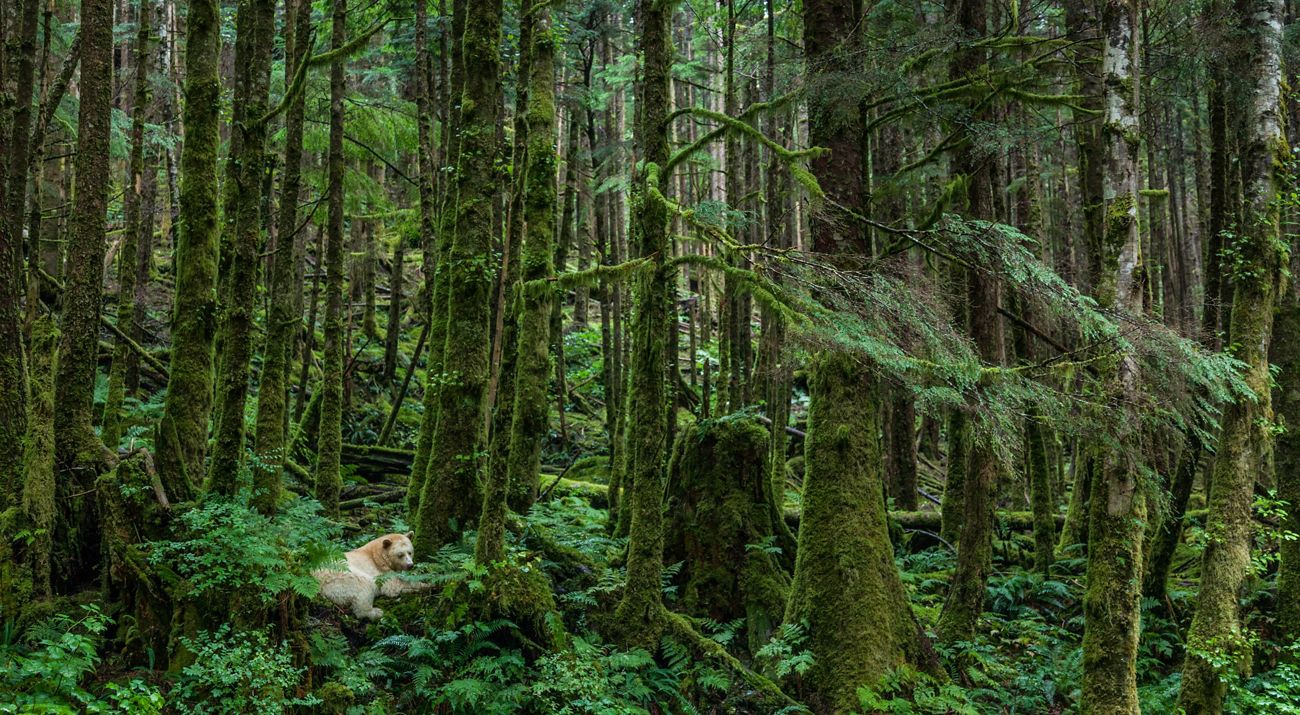Keepers of Great Bear
First Nations protected Canada’s Great Bear Rainforest for future generations. Now local communities are rebuilding ties to this land.
Spring 2017
Out on the remote coastal islands of British Columbia, where cedars tower overhead and ancient shell middens gleam by the cool green water, life’s problems seem to evaporate into the encircling mist. There is only the thrum of eagle wings, the splash of salmon, the comforting scrape of the boat resting against barnacle-covered rocks.
And the giggles of teenagers.
“Hearing kids’ laughter in the forest just fits—as much as the trees and the bears,” says Philip Charles, coordinator of the internship program that has brought the four high schoolers here. “It just feels right.”
The group falls into respectful silence as Doug Neasloss, chief councilor of the Kitasoo/Xai’xais Nation, to which they all belong, points out the ocher-red pictographs painted on a nearby cliff. He explains that the symbols indicate the presence of an ancestral gravesite. Then he scrambles onto a steeply angled wedge of rock leading up into the forest, some 20 feet above the boat’s hull.
“We’re going up there?” says one of the interns. “I can’t!”
But she does, and comes back glowing and grinning, having seen a centuries-old burial box considered so sacred that only members of the First Nations are permitted to approach it. And that’s not all. By the time the group returns home that night, they’ve touched the shells of clams consumed by generations past, snacked on a freshly cracked-open sea urchin, spotted two killer whales and bushwhacked into an island forest where no one else had walked in living memory.
The landscape is all part of life in the Great Bear Rainforest, which extends some 250 miles and encompasses 19 million acres along Canada’s Pacific coast. Nature United, The Nature Conservancy’s Canadian affiliate, has played a vital supporting role in creating permanent protection for this astonishing ecosystem. Among its many programs here over the past decade, TNC helped establish the Supporting Emerging Aboriginal Stewards (SEAS) initiative in three Great Bear communities.
Launched in 2009, SEAS uses hands-on internships and other educational experiences to help First Nations youth connect with the landscape and culture of their traditional territories. A youth program might seem a bit tangential for a conservation organization, but it’s actually a powerful way to protect the future of this landscape, says Jenny Brown, director of conservation for Nature United.
In recent decades, the Kitasoo/Xai’xais have used their aboriginal rights to effectively assert authority over their territory and take the lead on managing its natural resources. That makes reconnecting kids to traditional roles as land stewards a critical conservation investment. They will be the next generation of decision-makers for Great Bear’s forests and waters.
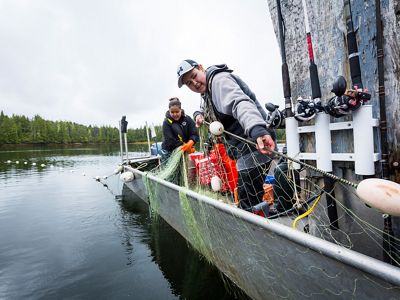
Not long ago, there was no Great Bear Rainforest, merely the “Mid-Coast Timber Supply Area.” The poetic rebranding dates to the mid-1990s, when a coalition of environmental groups launched a powerful campaign against old-growth logging in one of the world’s largest and last intact coastal temperate rainforests.
The name Great Bear pays homage to the forest’s many ursine residents: grizzlies, black bears and even what look at first glance like lost polar bears, thanks to a genetic quirk that gives some black bears white coats. Locals call these rare white animals “spirit bears,” and they are said to bring luck. Perhaps they have: The area has seen unprecedented collaboration between environmental and industrial groups, who agreed in 2008 to ban logging in one-third of the rainforest and embark on a sustainable management plan for the rest.
The Conservancy supported that historic agreement by raising $39 million to create the Coast Opportunity Funds, which has been used by local First Nations communities to build capacity for co-managing their own resources alongside the provincial government. The conservation endowment has helped First Nations, including the Kitasoo/Xai’xais, establish natural resources management divisions, scientific research and monitoring initiatives, and conservation education programs. Another part of the fund supports sustainable economic development initiatives in First Nations communities.
A decade of further negotiation culminated in 2016 with a final agreement, between the provincial government and 26 First Nations, on the future of 19 million acres in Great Bear. About 9 million of those acres are now protected from logging, with the balance managed under some of the world’s most stringent harvest standards.
“This is a really big deal,” Nature United’s Brown said at the time. “It lights the path for fulfilling a commitment to a future with some logging, sustainability of old-growth forests, and a vital and robust indigenous voice in this region.”
The deals shifted how First Nations are recognized, from stakeholders to rights holders. In the past, the communities could do little more than protest or go to court over unfavorable land-use decisions, says Brown. Now, the First Nations of Great Bear have gained a stronger voice in decisions regarding their territory.
But the communities also need to build the capacity to monitor and manage the Great Bear and its waters and to assert their authority. According to Brown, studies show that communities with long history and close ties to their land tend to manage resources with sustainability in mind.
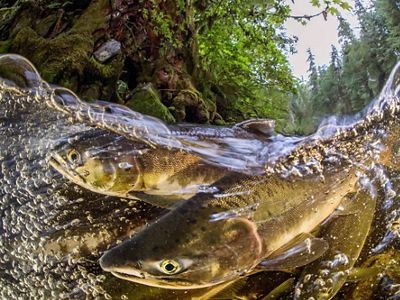
On a gray July morning in the village of Klemtu, two massive metal pots stuffed with jars of sockeye salmon bubble away on the front porch of Kitasoo/Xai’xais hereditary chief Ernest “Charlie” Mason Jr.’s house while he minds his family’s general store next door. Seated behind the counter, 73-year-old Mason is smiling, as usual, his face full of light and lines and stories. A hand-drawn heart is tattooed on his forearm—a mistake of his youth, he says sheepishly— and he is, in many ways, the heart of this small community.
A hand-held maritime-band radio crackles over the whir of the slushy machine, and Mason picks it up to listen. “It goes to all the houses,” he says. “We use it to announce meetings, tell someone when we’re going out fishing, check in on the older people and make sure they’re all right.” Making sure people are all right seems to be part of Mason’s DNA. As one of the few boat owners in this town of some 500 people, he feels a sense of responsibility to feed others—that’s why he’s canning far more salmon than his own family will need.
As a hereditary chief, he also feels a responsibility to share the legends and songs of his culture with anyone who wants to listen, especially the youth. He’s working hard to overcome a long legacy of cultural suppression rooted in something called residential schools.
From the late 19th century through much of the 20th—the last residential school closed in 1996—some 150,000 indigenous children in Canada were purposefully isolated from their families and communities and placed in church-run, government-funded boarding schools. The children were forbidden to speak their own languages or practice their traditions, and many were neglected and abused. At the time, proponents spoke of a desire to “civilize” the native peoples. In 2015, the Truth and Reconciliation Commission of Canada finally called the system what it was: cultural genocide. The scars have lasted generations. Today, isolated communities throughout the region grapple with issues like substance abuse, depression and domestic violence.
“I really feel strongly about the effects that residential school has had on our people,” says Roxanne Robinson, a language and culture teacher at the Kitasoo Community School in Klemtu, which has about 50 students in grades K-12. The SEAS program, which includes all the students during the school year and hires a few teens for paid internships each summer, is at the heart of her curriculum. The interns spend eight weeks discovering local traditions, including art, dance, medicine harvesting and canoeing, as well as helping with projects like monitoring natural resources and trail building.
There are no malls or burger joints around here where young people can get a summer job. That leaves teens with a lot of free time on their hands, which, as any parent can testify, can be a dangerous prospect. “We’re connecting them back to the Earth,” says Robinson. “We’re taking them out onto the land and teaching them skills that are going to last a lifetime. It keeps their minds busy, and they can never say that they’re bored.”
Throughout the year, Robinson supports Deanna Duncan, SEAS school coordinator, in organizing projects and excursions to help students reconnect with their cultural heritage, which is inextricably linked to their territory’s abundant natural resources. They weave crafts from cedar bark and go out with Chief Mason to harvest seasonal salmon, clams, herring eggs and seaweed, storing it all up to give away at a community feast each spring. Such ceremonies, called potlatches, were banned by the federal government from 1884 to 1951.
“The gap that the residential schools caused kind of made the generation before us not interested in learning the culture, not OK enough to teach it. That gap caused a break and a tear in the whole system,” says Mercy Mason, a bright 17-year-old entering her senior year. “Our generation is more into it. We say we don’t like our culture sometimes, but without it, we wouldn’t be who we are. Losing your culture is like losing your identity.”
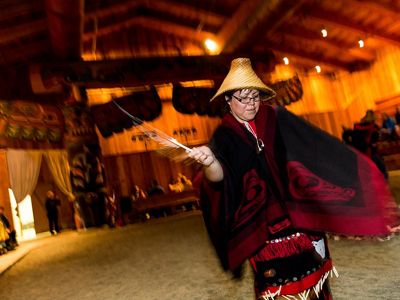
At first, some of the kids won't even touch the circular pieces of fresh animal hide, which feel like wet tortillas and give off a sharp, tangy animal scent. “Oh my God, it’s so gross,” says 12-year-old Mya Anderson, pretending to gag. “I’m not touching that!” But curiosity soon wins out. She pokes at it with a painted fingernail and gasps. “It’s squishy! Squish this! Squish this right here!” she squeals to the girl next to her, who tentatively complies. After sewing the hides onto cedar rings with long strips of hide pulled tight, their projects are finally complete: traditional drums.
Mercy, wearing a “Make Things Happen” T-shirt, is animated and giggling for the first hour or so of the drummaking workshop. She goofs around with her friends, wearing the rings of the cedar drum frames on her arms like giant bracelets. But after a while she sits down with a sad, vacant expression and becomes introverted.
“Sometimes, kids just switch off, and you know it’s because they’re going through something heavy,” youth coordinator Philip Charles says later. He has a big-brotherly connection with the kids. For many of them, growing up in the isolated communities is not easy.
Charles, 27, has a degree in animal conservation science, a British accent and a Peter Pan-like gleam in his eye. He grew up more than 4,000 miles away in the east of England but felt an immediate connection to Klemtu and its people when he first visited in 2010 to study the region’s bear population. He has returned seasonally ever since, earning the status of an honorary First Nations member.
Charles is the only one who can break through the blankness that has enveloped Mercy. He takes her outside to talk; when they return, she continues making her drum with renewed enthusiasm. At the same time, Mya is finishing up hers. “I’m going to paint my little sister’s handprint on it and give it to her,” she says, happily inspecting her drum.
Harvey Robinson, a hereditary elder leading the workshop, explains why: “It’s our culture: When you make something, you give the first one away.”
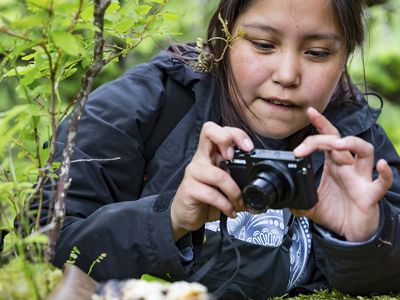
Although First Nations in the region recently won a major victory in fending off proposed oil shipping through Great Bear’s waters, other environmental threats remain. Overfishing and climate change threaten the health of salmon, crab and other culturally important species in many indigenous territories. The fragility of these resources was highlighted in October, when a tugboat ran aground on a reef near Bella Bella, spilling diesel fuel into a bay where the Heiltsuk Nation harvests clams and fish.
The Coast Opportunity Funds, which TNC helped create, also backed a program called the Coastal Stewardship Network in eight indigenous territories along the coast of British Columbia. The program’s rangers, called Guardian Watchmen, play an important role in combating overfishing by monitoring fish populations, recording fishing activity and helping enforce protected areas.
“We are out there monitoring our traditional territory for the Nation, ensuring there are enough resources there intact for generations to come,” says Chantal Pronteau, 22, a watchman with the Kitasoo/Xai’xais. She was a SEAS intern in 2013, an experience she credits with preparing her for this role as well as sparking her interest in archaeology and biology as career choices. “I always look back to that season and how much it helped me grow, and still is helping me grow.”
With year-round programs established in the communities of Klemtu, Bella Bella and Bella Coola, SEAS has touched the lives of some 350 youths a year in the Great Bear Rainforest, says Nature United’s Jenny Brown.
“After the [2008] Great Bear Rainforest agreement was signed, we kept showing up because we’re focused on building capacity in communities,” Brown says. “Now, I think things are in a much better spot for ensuring this place is conserved into the future, and every time I go out with SEAS kids, I feel that way.”
Neasloss, the chief councilor, agrees.
“I think SEAS is the single most successful program we have in this community,” he says. “It builds stewardship and helps young people understand the environmental issues and threats going on here. And in five to 10 years, these guys are going to be the ones sitting at the government tables, the ones becoming hereditary chiefs and chief councilors. Things are changing so much for First Nations right now, and these kids have a really unique opportunity to help shape the future.”
